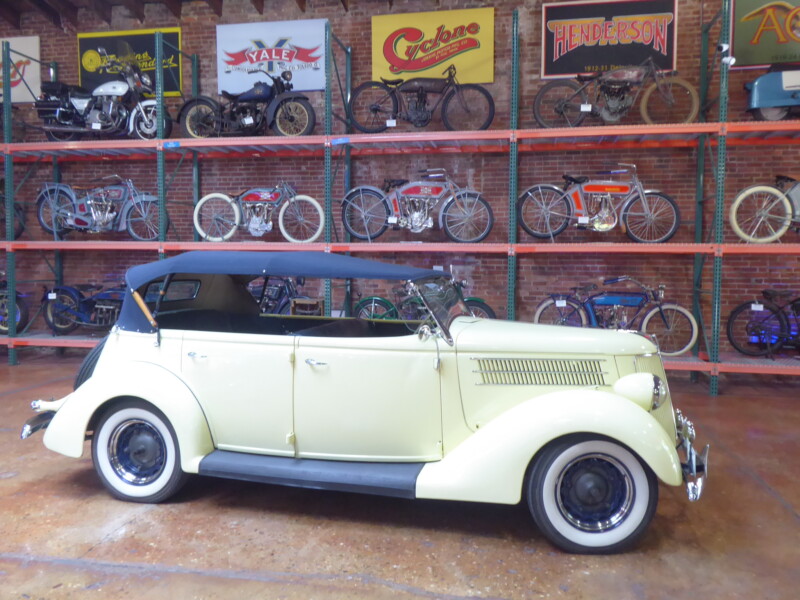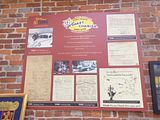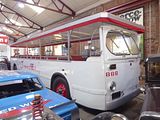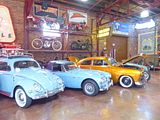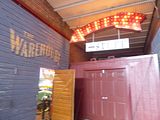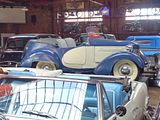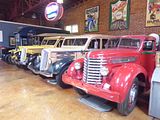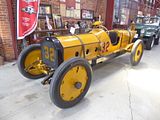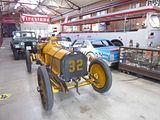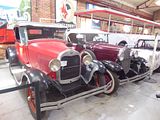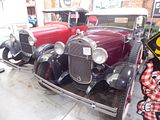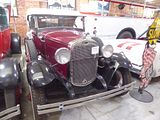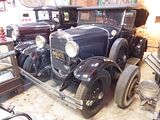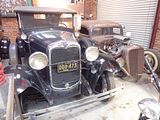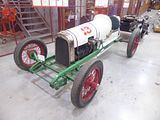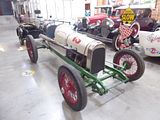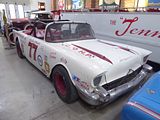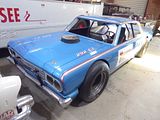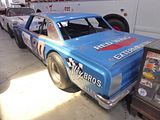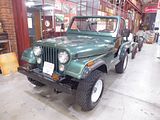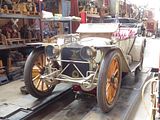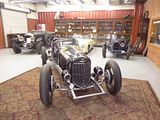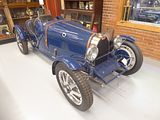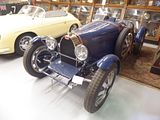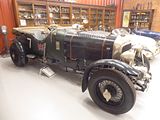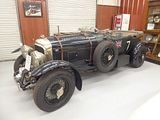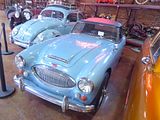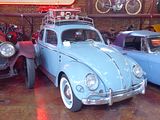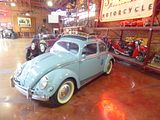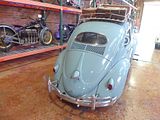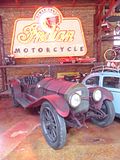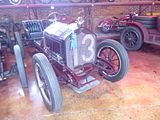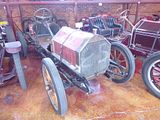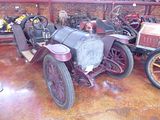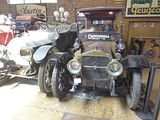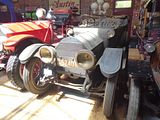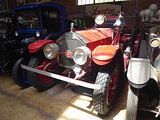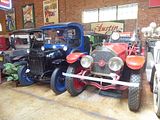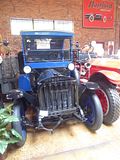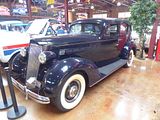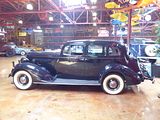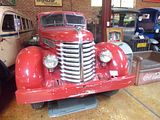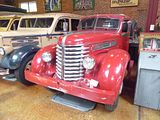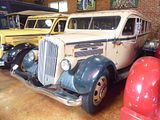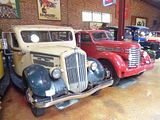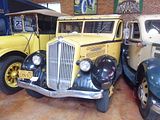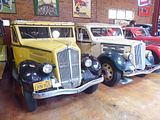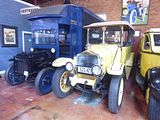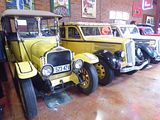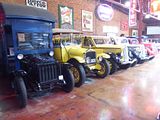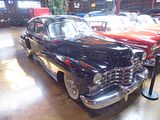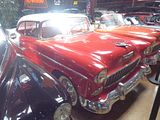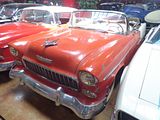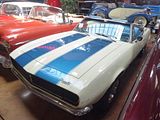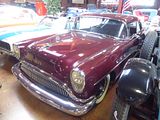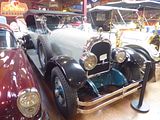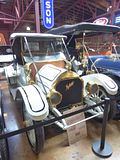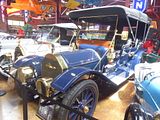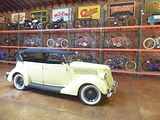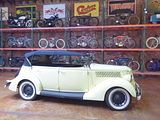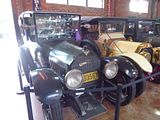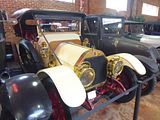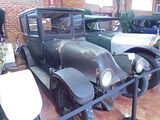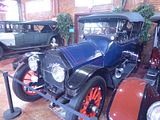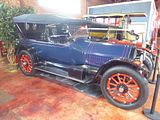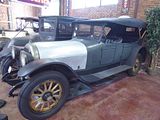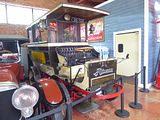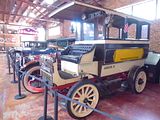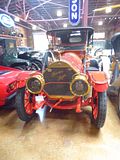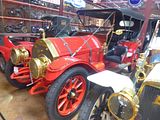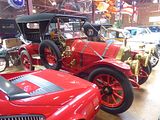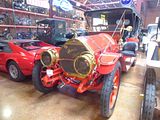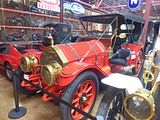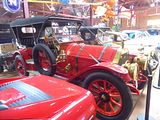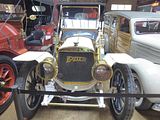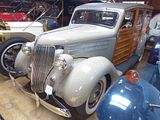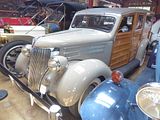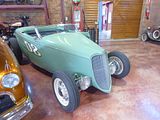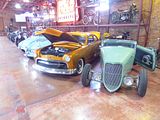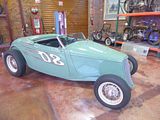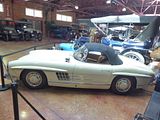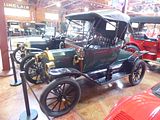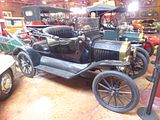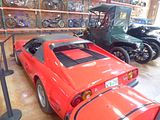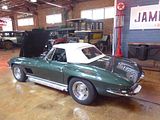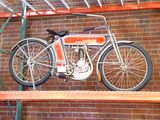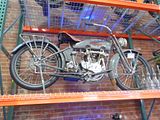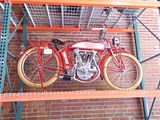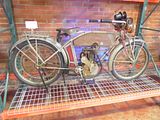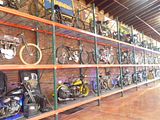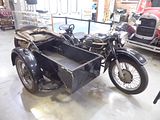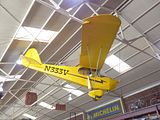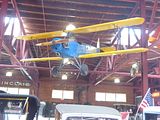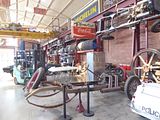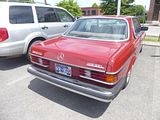My first trip to the deep South of the USA was indeed planned around a couple of car museums that I have longed wanted to visit. The Coker Museum was not one of them. Indeed, I will confess that I’d never even heard of it until I arrived in Chattanooga. When I checked into my hotel on the outskirts of the city, I picked up some of the usual tourist material for this city that most people have heard of, thanks to a certain song made popular in 1941, including a city map and on the bottom of it was an advert for the Coker Museum. That piqued my interest and I made a more or less immediate plan to visit especially as I discovered that it was only a few blocks away from the famous ChooChoo that I also wanted to see whilst I was in town. The Coker Museum takes its name from Corky Coker, and houses Corky Coker’s personal collection. Corky grew the collection during his career at Coker Tire. With over 100 vintage cars, motorcycles, trucks, buses, and even 3 airplanes hanging overhead. It is housed in what was once a White Truck Dealership at the turn of the century as well as Coker Tire’s inventory for many years.
Further historic interest comes from the fact that this is home of Honest Charley’s Speed Shop, which was the world’s first mail order business for auto tuning parts, established in 1948. Honest Charley was an American businessman and pioneer in the high performance automotive parts industry. Born Charles Edward Card Jr. (January 18, 1905 – October 26, 1974), he was known throughout the racing and hot rod communities by the trade name Honest Charley. In 1948 he created the Honest Charley’s Speed Shop in Chattanooga, Tennessee in the United States. The company became well known for its unique and entertaining catalogs which were originally hand drawn. Honest Charley’s also attracted the attention of the aftermarket parts industry for its innovative distribution techniques. He was a racing enthusiast, patron and sponsor. He was a USAC Life Time Member with member number 121 and early member of the Indy 500 Old Timers Club. In 1970 he became the second inductee into Specialty Equipment Market Association (SEMA) Hall of Fame. Honest Charley’s father was of Scottish descent and lived in New Jersey.[3] During the reconstruction era following the American Civil War, Charles Card Sr. moved south and started a wholesale produce company which prospered for 48 years as Chattanooga increasingly grew as an industrial and manufacturing centre especially during World War I. While working 17 years in his father’s business, he developed a strong work ethic and a good sense for business, but it was maintaining the truck fleet that first interested him in customizing automobiles. In 1940 he opened a restaurant on Chestnut Street in downtown Chattanooga just opposite the Read House. In an effort to increase profit he removed the cash register to make room for one more paying customer at the counter. When patrons would come out, he would ask them what they owed and collect from them as they had reported. People frequently commented “You sure are honest, Charley.” He adopted the nickname and put it on his sign. Embracing a local colloquialism he also added the suffix “Hisself” and was often referred to as Honest Hisself. During the ’40s he spent many weekends driving to stock car races with his wife, Grace, and two daughters, Martha and Ann and a trunkful of racing parts for sale or trade. After several years of networking and getting to know the drivers and the market, he decided to take the next step, and in 1948 he started Honest Charley’s Speed Shop along with his son-in-law Robert J. Espy as a partner. They began with a modest retail front of just 260 square feet at 2204 McCallie Ave. From the beginning Honest Charley’s was best known for its entertaining and unique catalog. The early issues were actually hand drawn by Honest and his daughters. He created a caricature of “Hisself” for a logo and always drew little cartoons in the margins. Aside from the entertainment value, the catalogs established Honest Charley’s as the first coast-to-coast mail order distributor of high-performance aftermarket parts. Honest Charley’s keen sense of business put him in the forefront of an industry which was poised for growth. After World War II, many returning soldiers had a great deal of mechanical aptitude after keeping GI vehicles running on the battlefield, and they had a need for excitement.[citation needed] Hot rods were made popular by magazines and movies. Hot Rod (1950), The Fast And The Furious (1954) and Running Wild (1955) and other movies were in theatres. Pete Petersen began publishing Hot Rod Magazine with encouragement and capital investment from Honest Charley, who was also an advertiser in the first issue. As business grew, Honest Charley’s Speed Shop moved to a larger 14,000 square foot store at 3813 Rossville Blvd. In 1964 Honest designed and built a state-of-art 30,000 square foot distribution warehouse at 108 Honest Street off Lee Hwy. near the runway of Lovell Field. While attending major races such as the Indianapolis 500, Honest established personal relationships with many of the West Coast manufacturers like Vic Edelbrock, Fred Offenhauser, Phil Weiand, Ed Iskenderian (Isky Cams), Els Lohn (Eelco), Willie Garner (Trans Dapt), Paul Schiefer, and George Hurst. Through this network he was able to influence output supply and avoid backorder problems which negatively affected other distributors. Also he was also able to have some products labelled as his own brand. In addition to retail, Honest Charley’s sold wholesale to many small chains and independent stores. In the 1970s the company began franchising smaller stores across the southeast. Honest Charley built several race cars during the early years of the Speed Shop. Each was recognizable by his company name hand painted on the side of the car. In 1953 on the Daytona Beach Road Course his modified ’39 Ford sedan with a Mercury 59A engine won the Daytona Century Race with a speed of 137 mph. He was a major sponsor of drag racers “TV Tommy” Ivo and “Jungle Jim” Liberman, both of whom prominently displayed his logo on their cars. From 1971-72 he sponsored the NHRA sanctioned All-American Stars & Stripes Whole Earth Open Drags race at Beech Bend Park in Bowling Green, KY. He attended the Indy 500 every year from the ’30s to the ’70s. He was well known at many other tracks such as Daytona and Bristol. Honest Charley died in 1974. His son-in-law and partner Robert J. Espy continued to operate the company until it succumbed in 1990 to an ever-increasing competition of larger retailers entering the market and restrictive environmental regulations regarding aftermarket alteration of automobiles. In 1998 Coker Tire of Chattanooga acquired the brand rights and revitalized the name Honest Charley’s Speed Shop as an internet retailer. They also have a retail front and garage on Chestnut Street just a few blocks from where Honest Charley’s restaurant once stood. In the garage they build and restore custom hot rods and motorcycles and have been featured on cable TV shows such as American Pickers and Car Wars.
And so to the displays. There’s a real treasure trove of stuff here, some of it familiar and plenty of it that certainly is not.
1911 Marmon Wasp (replica): Marmon Motor Car Company was an automobile manufacturer in the early 1900s. The company created some buzz in 1911 when the Marmon Wasp won the first Indianapolis 500 race. Named for its unique colour scheme and shape of its tail, the Wasp secured its place in racing history from the engineering and driving by Marmon’s Ray Harroun and his team. At the time, racing cars were all two seaters, which allowed the riding mechanic to tag along and watch for approaching cars. Defying convention, Marmon built a single seater, saving on weight and allowing for a streamlined body. To calm safety concerns, Harroun improvised by adding a rearview mirror, believed to be the first one installed on a car. Key to the outcome of the race was Marmon’s approach to tires. Blown tires were common and downtime significant. Marmon engineers determined that if their car ran five miles per hour slower than the maximum safe speed, they could double the tire life. It worked! The Wasp had four pit stops and no blowouts on race day, compared to the second-place car with 11 stops and 14 tires changed. Marmon Motor Car’s highly disciplined approach worked — combining innovation, differentiation and an intense focus on what mattered most to winning. While the company did not survive the Great Depression, the Marmon business name continued when Walter Marmon started a new company called Marmon-Herrington. By the early 1960s, Marmon-Herrington was one of a dozen industrial businesses owned by the Pritzker family of Chicago. In 1964, the Marmon name was chosen for the growing group of companies.
1929 and 1930 Ford Model A: The Ford Model A was the Ford Motor Company’s second market success after its predecessor, the Model T. First produced on October 20, 1927, but not introduced until December 2, it replaced the venerable Model T, which had been produced for 18 years. This new Model A (a previous model had used the name in 1903–04) was designated a 1928 model and was available in four standard colours. By February 4, 1929, one million Model As had been sold, and by July 24, two million. The range of body styles ran from the Tudor at US$500 (in grey, green, or black) to the Town Car with a dual cowl at US$1200. In March 1930, Model A sales hit three million, and there were nine body styles available. Prices for the Model A ranged from US$385 for a roadster to US$1400 for the top-of-the-line Town Car. The engine was a water-cooled L-head inline four with a displacement of 3.3 litre. This engine provided 40 bhp. Top speed was around 65 mph (105 km/h). The Model A had a 103.5 in (2,630 mm) wheelbase with a final drive ratio of 3.77:1. The transmission was a conventional unsynchronized three-speed sliding gear manual with a single speed reverse. The Model A had four-wheel mechanical drum brakes. The 1930 and 1931 models were available with stainless steel radiator cowling and headlamp housings. The Model A came in a wide variety of styles including a Coupe (Standard and Deluxe), Business Coupe, Sport Coupe, Roadster Coupe (Standard and Deluxe), Convertible Cabriolet, Convertible Sedan, Phaeton (Standard and Deluxe), Tudor Sedan (Standard and Deluxe), Town Car, Fordor (five-window standard, three-window deluxe), Victoria, Town Sedan, Station Wagon, Taxicab, Truck, and Commercial. The very rare Special Coupe started production around March 1928 and ended mid-1929. The Model A was the first Ford to use the standard set of driver controls with conventional clutch and brake pedals, throttle, and gearshift. Previous Fords used controls that had become uncommon to drivers of other makes. The Model A’s fuel tank was situated in the cowl, between the engine compartment’s fire wall and the dash panel. It had a visual fuel gauge, and the fuel flowed to the carburettor by gravity. A rear-view mirror was optional. In cooler climates, owners could purchase an aftermarket cast iron unit to place over the exhaust manifold to provide heat to the cab. A small door provided adjustment of the amount of hot air entering the cab. The Model A was the first car to have safety glass in the windshield. Model A production ended in March 1932, after 4,858,644 had been made in all body styles. Its successor was the Model B, which featured an updated inline four-cylinder engine, as well as the Model 18, which introduced Ford’s new flathead (sidevalve) V8 engine.
1925 Frontenac
1957 Chevrolet Corvette
1964 Chevrolet Chevelle
Jeep CJ-6
1913 American Underslung
1933 Shafer 8
1928 Bugatti Type 35b Replica: Very well known as a model, indeed many would tell you that this is THE classic Bugatti, is the Type 35 and there were a number of these here. The Type 35 was phenomenally successful, winning over 1,000 races in its time. It took the Grand Prix World Championship in 1926 after winning 351 races and setting 47 records in the two prior years. At its height, Type 35s averaged 14 race wins per week. Bugatti won the Targa Florio for five consecutive years, from 1925 through 1929, with the Type 35. The original model, introduced at the Grand Prix of Lyon on August 3, 1924, used an evolution of the 3-valve 1991 cc overhead cam straight-8 engine first seen on the Type 29. Bore was 60 mm and stroke was 88 mm as on many previous Bugatti models. 96 examples were produced. This new powerplant featured five main bearings with an unusual ball bearing system. This allowed the engine to rev to 6000 rpm, and 90 hp was reliably produced. Solid axles with leaf springs were used front and rear, and drum brakes at back, operated by cables, were specified. Alloy wheels were a novelty, as was the hollow front axle for reduced unsprung weight. A second feature of the Type 35 that was to become a Bugatti trademark was passing the springs through the front axle rather than simply U-bolting them together as was done on their earlier cars. A less expensive version of the Type 35 appeared in May, 1925. The factory’s Type 35A name was ignored by the public, who nicknamed it “Tecla” after a famous maker of imitation jewellery. The Tecla’s engine used three plain bearings, smaller valves, and coil ignition like the Type 30. While this decreased maintenance requirements, it also reduced output. 139 of the Type 35As were sold. The Type 35C featured a Roots supercharger, despite Ettore Bugatti’s disdain for forced induction. Output was nearly 128 hp with a single Zenith carburettor. Type 35Cs won the French Grand Prix at Saint-Gaudens in 1928, and at Pau in 1930. Fifty examples left the factory. The final version of the Type 35 series was the Type 35B of 1927. Originally named Type 35TC, it shared the 2.3 litre engine of the Type 35T but added a large supercharger like the Type 35C. Output was 138 hp, and 45 examples were made. A British Racing Green Type 35B driven by William Grover-Williams won the 1929 French Grand Prix at Le Mans.
1956 Porsche 356B: The 356 was created by Ferdinand “Ferry” Porsche (son of Dr. Ing. Ferdinand Porsche, founder of the German company), who founded the Austrian company with his sister, Louise. Like its cousin, the Volkswagen Beetle (which Ferdinand Porsche Senior had designed), the 356 was a four-cylinder, air-cooled, rear-engine, rear-wheel-drive car utilising unitised pan and body construction. The chassis was a completely new design as was the 356’s body which was designed by Porsche employee Erwin Komenda, while certain mechanical components including the engine case and some suspension components were based on and initially sourced from Volkswagen. Ferry Porsche described the thinking behind the development of the 356 in an interview with the editor of Panorama, the PCA magazine, in September 1972. “….I had always driven very speedy cars. I had an Alfa Romeo, also a BMW and others. ….By the end of the war I had a Volkswagen Cabriolet with a supercharged engine and that was the basic idea. I saw that if you had enough power in a small car it is nicer to drive than if you have a big car which is also overpowered. And it is more fun. On this basic idea we started the first Porsche prototype. To make the car lighter, to have an engine with more horsepower…that was the first two seater that we built in Carinthia (Gmünd)”. The first 356 was road certified in Austria on June 8, 1948, and was entered in a race in Innsbruck where it won its class. Porsche re-engineered and refined the car with a focus on performance. Fewer and fewer parts were shared between Volkswagen and Porsche as the ’50’s progressed. The early 356 automobile bodies produced at Gmünd were handcrafted in aluminium, but when production moved to Zuffenhausen, Germany in 1950, models produced there were steel-bodied. Looking back, the aluminium bodied cars from that very small company are what we now would refer to as prototypes. Porsche contracted with Reutter to build the steel bodies and eventually bought the Reutter company in 1963. The Reutter company retained the seat manufacturing part of the business and changed its name to Recaro. Little noticed at its inception, mostly by a small number of auto racing enthusiasts, the first 356s sold primarily in Austria and Germany. It took Porsche two years, starting with the first prototype in 1948, to manufacture the first 50 automobiles. By the early 1950s the 356 had gained some renown among enthusiasts on both sides of the Atlantic for its aerodynamics, handling, and excellent build quality. The class win at Le Mans in 1951 was clearly a factor. It was always common for owners to race the car as well as drive them on the streets. They introduced the four-cam racing “Carrera” engine, a totally new design and unique to Porsche sports cars, in late 1954. Increasing success with its racing and road cars brought Porsche orders for over 10,000 units in 1964, and by the time 356 production ended in 1965 approximately 76,000 had been produced. The 356 was built in four distinct series, the original (“pre-A”), followed by the 356 A, 356 B, and then finally the 356 C. To distinguish among the major revisions of the model, 356’s are generally classified into a few major groups. 356 coupés and “cabriolets” (soft-top) built through 1955 are readily identifiable by their split (1948 to 1952) or bent (centre-creased, 1953 to 1955) windscreens. In late 1955 the 356 A appeared, with a curved windshield. The A was the first road going Porsche to offer the Carrera 4 cam engine as an option. In late 1959 the T5 356 B appeared; followed by the redesigned T6 series 356 B in 1962. The final version was the 356 C, little changed from the late T6 B cars but with disc brakes to replace the drums.
1927 Bentley 4.5 litre: Bentley replaced the 3 Litre with a more powerful car by increasing its engine displacement to 4.5 litres. As before, Bentley supplied an engine and chassis and it was up to the buyer to arrange for their new chassis to be fitted with one of a number of body styles, most of which were saloons or tourers. Very few have survived with their four-seater coachwork intact. WO Bentley had found that success in motorsport was great publicity for the brand, and he was particularly attracted to the 2 Hours of Le Mans endurance race, the inaugural running of which took place 26–27 May 1923, attracting many drivers, mostly French. There were two foreign competitors in the first race, Frank Clement and Canadian John Duff, the latter winning the 1924 competition in his personal car, a Bentley 3 Litre. This success helped Bentley sell cars, but was not repeated, so ater two years without success, Bentley convened a group of wealthy British men, “united by their love of insouciance, elegant tailoring, and a need for speed,” to renew Bentley’s success. Both drivers and mechanics, these men, later nicknamed the “Bentley Boys”, drove Bentley automobiles to victory in several races between 1927 and 1931, including four consecutive wins at the 24 Hours of Le Mans, and forged the brands reputation. It was within this context that, in 1927, Bentley developed the Bentley 4½ Litre. Two cylinders were removed from the 6½ Litre model, reducing the displacement to 4.4 litres. At the time, the 3 Litre and the 6½ Litre were already available, but the 3 Litre was an outdated, under-powered model and the 6½ Litre’s image was tarnished by poor tyre performance. Sir Henry “Tim” Birkin, described as “the greatest British driver of his day” by W. O. Bentley, was one of the Bentley Boys. He refused to adhere strictly to Bentley’s assertion that increasing displacement is always preferable to forced induction. Birkin, aided by a former Bentley mechanic, decided to produce a series of five supercharged models for the competition at the 24 Hours of Le Mans; thus the 4½ litre Blower Bentley was born. The first supercharged Bentley had been a 3-litre FR5189 which had been supercharged at the Cricklewood factory in the winter of 1926/7. The Bentley Blower No.1 was officially presented in 1929 at the British International Motor Show at Olympia, London. The 55 copies were built to comply with 24 Hours of Le Mans regulations. Birkin arranged for the construction of the supercharged cars having received approval from Bentley chairman and majority shareholder Woolf Barnato and financing from wealthy horse racing enthusiast Dorothy Paget. Development and construction of the supercharged Bentleys was done in a workshop in Welwyn by Amherst Villiers, who also provided the superchargers. W.O. Bentley was hostile to forced induction and believed that “to supercharge a Bentley engine was to pervert its design and corrupt its performance.” However, having lost control of the company he founded to Barnato, he could not halt Birkin’s project. Although the Bentley 4½ Litre was heavy, weighing 1,625 kg (3,583 lb), and spacious, with a length of 172 in and a wheelbase of 130.0 in, it remained well-balanced and steered nimbly. The manual transmission, however, required skill, as its four gears were unsynchronised. The robustness of the 4½ Litre’s latticed chassis, made of steel and reinforced with ties, was needed to support the heavy cast iron inline-four engine. The engine was “resolutely modern” for the time. The displacement was 4,398 cc. Two SU carburettors and dual ignition with Bosch magnetos were fitted. The engine produced 110 hp for the touring model and 130 hp for the racing model. The engine speed was limited to 4,000 rpm. A single overhead camshaft actuated four valves per cylinder, inclined at 30 degrees. This was a technically advanced design at a time where most cars used only two valves per cylinder. The camshaft was driven by bevel gears on a vertical shaft at the front of the engine, as on the 3 Litre engine. The essential difference between the Bentley 4½ Litre and the Blower was the addition of a Roots-type supercharger to the Blower engine by engineer Amherst Villiers, who had also produced the supercharger. W. O. Bentley, as chief engineer of the company he had founded, refused to allow the engine to be modified to incorporate the supercharger. As a result, the supercharger was placed at the end of the crankshaft, in front of the radiator. This gave the Blower Bentley an easily recognisable appearance and also increased the car’s understeer due to the additional weight at the front. A guard protected the two carburettors located at the compressor intake. Similar protection was used, both in the 4½ Litre and the Blower, for the fuel tank at the rear, because a flying stone punctured the 3 Litre of Frank Clement and John Duff during the first 24 Hours of Le Mans, which contributed to their defeat. The crankshaft, pistons and lubrication system were special to the Blower engine. It produced 175 hp at 3,500 rpm for the touring model and 240 hp at 4,200 rpm for the racing version, which was more power than the Bentley 6½ Litre developed. Between 1927 and 1931 the Bentley 4½ Litre competed in several competitions, primarily the 24 Hours of Le Mans. The first was the Old Mother Gun at the 1927 24 Hours of Le Mans, driven as a prototype before production. Favoured to win, it instead crashed and did not finish. Its performance was sufficient for Bentley to decide to start production and deliver the first models the same year. Far from being the most powerful in the competitions, the 4½ Litre of Woolf Barnato and Bernard Rubin, raced neck and neck against Charles Weymann’s Stutz Blackhawk DV16, setting a new record average speed of 69 mph; Tim Birkin and Jean Chassagne finished fifth. The next year, three 4½ Litres finished second, third, and fourth behind another Bentley, the Speed Six, which possessed two more cylinders.The naturally aspirated 4½ Litre was noted for its good reliability. The supercharged models were not; the two Blower models entered in the 1930 24 Hours of Le Mans by Dorothy Paget, one of which was co-driven by Tim Birkin, did not complete the race. In 1930, Birkin finished second in the French Grand Prix at the Circuit de Pau behind a Bugatti Type 35. Ettore Bugatti, annoyed by the performance of Bentley, called the 4½ Litre the “fastest lorry in the world.” The Type 35 is much lighter and consumes much less petrol. Blower Bentleys consume 4 litres per minute at full speed. In November 1931, after selling 720 copies of the 4½ Litre – 655 naturally aspirated and 55 supercharged – in three different models (Tourer, Drophead Coupé and Sporting Four Seater, Bentley was forced to sell his company to Rolls-Royce for £125,175, a victim of the recession that hit Europe following the Wall Street Crash of 1929.
Austin Healey 3000: Donald Healey had been producing a range of expensive sports cars from the 1940s, cars such as the Silverstone, the Abbott and the Farnham. For the 1952 London Motor Show, he produced a new design, which was called the Healey Hundred, based on Austin A90 mechanicals, which he intended to produce in-house at his small car company in Warwick. It was one of the stars of the 1952 Show, and it so impressed Leonard Lord, the Managing Director of Austin, who was looking for a replacement to the unsuccessful A90. that Lord struck a deal with Healey on the spot, to build it in quantity. Bodies made by Jensen Motors would be given Austin mechanical components at Austin’s Longbridge factory. The car was renamed the Austin-Healey 100, in reference to the fact that the car had a top speed of 100 mph. Production got under way in 1953, with Austin-Healey 100s being finished at Austin’s Longbridge plant alongside the A90 and based on fully trimmed and painted body/chassis units produced by Jensen in West Bromwich—in an arrangement the two companies previously had explored with the Austin A40 Sports. By early 1956, production was running at 200 cars a month, 150 of which were being sold in California. Between 1953 and 1956, 14,634 Austin-Healey 100s were produced, the vast majority of them, as was the case for most cars in this post war era, going for export. The car was replaced by an updated model in 1956, called the 100-6. It had a longer wheelbase, redesigned bodywork with an oval shaped grille, a fixed windscreen and two occasional seats added (which in 1958 became an option with the introduction of the two-seat BN6 produced in parallel with the 2+2 BN4), and the engine was replaced by one based on the six-cylinder BMC C-Series engine. In 1959, the engine capacity was increased from 2.6 to 2.9 litres and the car renamed the Austin-Healey 3000. Both 2-seat and 2+2 variants were offered. It continued in this form until production ceased in late 1967. The Big Healey, as the car became known after the 1958 launch of the much smaller Austin-Healey Sprite, is a popular classic now. You come across the 3000 models more frequently than the 100s, as they accounted for more than 60% of all Big Healey production
Volkswagen 1200
1913 Interstate
1913 National
1908 American Simplex 50HP
1911 Mercer
1913 White-Whisky
1913 Cadillac Model 30: The Cadillac Model Thirty is an automobile that was introduced in December 1909 by the Cadillac Division of General Motors, and sold through 1911. It was the company’s only model for those years and was based on the 1907 Model G. The 1912 Model 1912, 1913 Model 1913, and 1914 Model 1914 were similar but used larger engines. This platform only used a four-cylinder engine which was permanently cancelled in 1914, as other GM brands would take on the task of offering a less prestigious engine. The 1912 Model 30 was the first production car to have an electric starter (as do all modern cars) rather than a hand crank or spring or other early method. The 1910 model was available with a closed body, the first time a US automobile manufacturer had offered this type.
1925 American La France
1925 Federal Fast Express
1936 Packard 120 B Sedan
1941 Diamond T 50 3 1 Ton
1937 White – Yellowstone Tour Bus: The Model 706 has been a mainstay in Western U.S. parks since one took its maiden voyage at Yosemite in 1935 under the watchful eyes of park authorities and transportation officials. Ford, REO, GMC, and White were asked to build tour buses that could haul sightseers comfortably along the park’s rugged, challenging roads. The entrants followed a route loaded with enough weight to simulate a full complement of passengers. White’s 706, powered by the 318-cu.in. flathead six used in White 700 series trucks, outperformed the rest of the pack, and became the de facto hauler for years to come. “An original 706 can climb just about every pass in Yellowstone in third gear,” John said. “They were specifically designed for touring in the park, with an average speed of 17-20 mph. That was when the world was running at a little different pace than it is today.” With less than 100 hp on tap, White relied on deep gearing to keep these buses rolling over Yellowstone’s roads. “They had a top speed of about 35 mph,” John said. “They weren’t a fast vehicle.” The 706’s enduring design is attributed to industrial stylist Count Alexis de Sakhnoffsky, as well as White President F.W. Black, and Herman Bender of the Bender Body Company. The front-end treatment was the same used on White’s commercial haulers penned by de Sakhnoffsky for the 1936 model year, and everything aft of the cowl was built by the Bender Body Company. In addition to the signature roll-back top, the buses had four to five right-side passenger doors, depending on configuration, but just one door, for the driver, on the left side. In 1936, 27 706s were roaming through Yellowstone, and by 1940 the fleet had grown to nearly 100. These grand old buses were used until more modern, larger rigs began replacing them in the 1950s. Over the ensuing years, the 706s were sold off until they’d been phased out altogether in the 1960s. More recently, a number have been bought back, and refurbished with modern running gear and so you may still see one at Yellowstone National Park.
1936 White – Yellowstone Tour Bus: The 706s weren’t the first Whitebrand people movers used in Yellowstone. In 1917, the Cleveland, Ohio-based manufacturer supplied Yellowstone’s tour operator with 100 buses and more than a dozen touring cars to replace horse-drawn stage coaches. White continued to supply the Yellowstone Transportation Company with buses and cars through the 1920s. The Model 614 was the predecessor of the 706, and it arrived in 1931. Earlier White coaches had open tops or open sides with a roof, like a huckster body, but the 614 had side windows and a fixed top with a roll-back fabric insert that foreshadowed the setup used on the 706.
1925 White Model 15-45
1921 Federal Fast Express
1948 Cadillac Series 62: The first all-new postwar Cadillacs arrived in 1948, sporting tail fins inspired by the Lockheed P-38 fighter plane on a Cadillac. Series 62 Cadillacs had a slightly shortened wheelbase, but the track width was increased by two inches, increasing interior room. However, updated drivetrains would have to wait another year and for the time being, the new Cadillacs were still powered by the same 346 CID flathead V8 used across the board since 1941, which delivered only fair performance (0-60 in 16 seconds with a top speed of 93 mph). Fuel mileage was an estimated 14 mpg highway, 10 mpg city with the Hydramatic transmission, which was rapidly becoming the norm — by 1949, only 10% of Cadillacs were ordered with the 3-speed manual gearbox. Series 62 production totalled 34,213 vehicles for the 1948 model year, accounting for 68% of Cadillac’s volume. The 1948 models had been slow to get into production and did not arrive in showrooms until February 1948, consequently Cadillac produced only 50,599 total vehicles for the abbreviated model year. The new Cadillac OHV V8 was the big news for 1949, with minor trim differences otherwise. This 331 cu in (5.4 L) engine produced 160 hp and weighed 200 pounds less than the old flathead V8 in addition to being shorter and lower. The 331 V8 could also handle higher compression levels to take advantage of improved, higher octane postwar gasoline formulations. The major difference between Series 61 and Series 62 models of similar body style was minor trim variations. The higher-priced series again had grooved, front fender stone shields and bright rocker panel mouldings. Chevrons below the taillights were no longer seen. The convertible was an exclusive offering. A heater was optional. Sales reached a record 55,643. The Cadillac Series 62 Coupe de Ville was introduced late in the 1949 model year. Along with the Buick Roadmaster Riviera, and the Oldsmobile 98 Holiday, it was among the first pillarless hardtop coupes ever produced. At $3,496 it was only a dollar less than the Series 62 convertible, and like the convertible, it came with power windows standard. It was luxuriously trimmed, with leather upholstery and chrome ‘bows’ in the headliner to simulate the ribs of a convertible top. 55,643 Series 62 Cadillacs were produced in 1949 out of a total volume of 92,554 vehicles. For 1950, major styling changes were performed. The cars were lower and sleeker, with longer hoods, and one-piece windshields were fitted. Hydra Matic transmission was now standard. The Series 61 was again a short wheelbase model, having been reduced to 122 in (3099 mm). Sales set yet another record at 59,818. Full-length chrome rocker panels set off the 1951 model, and the Coupe de Ville was now marked with noticeably-improved trim, including Coupe de Ville script on the rear roof pillar. Sales were 81,844, or a record of over 74% of all Cadillacs sold. Popular Mechanics reported about 12-MPG at 45 mph. In 1952, to commemorate the 50th anniversary of Cadillac, the V-shaped hood and deck emblems were done as gold castings. The Series 62 sedan was also characterized by a higher rear deck lid contour. This provided additional luggage space. Back up lights were now standard equipment and were incorporated in the taillights. The grille wraparound panels were redesigned once again having broad chrome trim below each headlight with side scoop styling and gold-colored winged emblem mounted in the center. At the rear all Cadillacs adopted a through the bumper dual exhaust system. Deck ornamentation took the form of a Cadillac crest over a broad golden “V”. New standard features included self-winding clocks, improved direction signal indicators, glare proof mirrors, stannate treated pistons, and four barrel carburetion. Engine output for the 331 was up to 190 hp. Sales fell to 70,255, but with the Series 61 out of the way, Series 62 sales accounted for a record 78% of all Cadillacs. The 1953 Series 62 saw a redesigned grille with heavier integral bumper and bumper guards, the repositioning of parking lamps directly under the headlights, chrome “eyebrow” type headlamp doors, and one piece rear windows without division bars. Wheel discs were fashioned in an attractive new disced design. Series 62 bodystyles were identified by non louvered rear fenders, the use of thin bright metal underscores on the bottom rear of the cars only and the decoration of both hood and deck lid with Cadillac crests and V-shaped ornaments. The Club Coupe model disappeared. Two door Series 62 were now all hardtops (including the better equipped Coupe de Ville) or convertibles. Another familiar name appeared on 1953’s Series 62. The top-of-the-line subseries Eldorado was one of three specialty convertibles produced in 1953 by General Motors, the other two being the Oldsmobile 98 Fiesta and the Buick Roadmaster Skylark. The Eldorado was a limited-edition luxury convertible, and would eventually become its own series. It featured a full assortment of deluxe accessories, including wire wheels, and introduced the wraparound windshield to Cadillac standard production. Sales set a new record at 85,446.
1955 Chevrolet Bel Air 2 door Hardtop and Convertible: Chevrolet replaced the entire range of cars for 1955, producing what are sometimes referred to as the “Tri-Five” range, which would live for three years. Revolutionary in their day, they spawned a cult following that exists in clubs, website and even entire businesses that exclusively cater to the enthusiasts of the Tri Five automobiles. All featured a front-engine, rear-wheel-drive layout. They remain some of the most popular years for collectors and hot rodders. 1955-1957 were watershed years for Chevrolet, who spent a million dollars in 1956 alone for retooling, in order to make their less expensive Bel Air models look more like a Cadillac, culminating in 1957 with their most extravagant tailfins and Cadillac inspired bumper guards. In 1955, Americans purchased 7.1 million new automobiles, including 1.7 million Chevrolets, giving the company fully 44% of the low-price market and surpassing Ford in total unit sales by 250,000. The Bel Air was an instant hit with consumers, with Base One-Fifty models starting under $1600 and featuring a six cylinder engine. The introduction of the new optional 170 hpr 265ci V8, coupled with the Powerglide automatic transmission quickly earned the model the nickname “The Hot One”. In the first year of production, the oil filter was considered an option, although not having it led to significantly shorter engine life. With three basic model lines of 150, 210 and Bel Air and a range of body styles from 2 and 4 door Sedans to Coupes, Convertibles and Wagons, there were as many as 19 different Tri-five models available. The 1956 cars saw minor changes to the grille, trim and other accessories. It meant huge gains in sales for Chevrolet, who sold 104,849 Bel Air models, due in part to the new V8 engine introduced a year before. By this time, their 265cid V8 had gained popularity with hot rodders who found the engine easy to modify for horsepower gains. This wasn’t lost on Chevrolet’s engineers, who managed to up the horsepower in 1956 from 170 hp to 225 hp with optional add-ons. The average two door Bel Air in 1956 sold for $2100, which was considered a good value at the time. Prices ranging from $1665 for the 150 sedan with six cylinder engine to $2443 for the V8 equipped convertible, with Nomad models running slightly higher. Bigger changes came for 1957, including the large tailfins, “twin rocket” bonnet design, even more chrome, tri-colour paint and a choice from no less than seven different V8 engines. While in 1957, Ford outsold Chevrolet for the first time in a great while, years later the used 1957 Chevrolets would sell for hundreds more than their Ford counterparts. As the horsepower race continued, Chevrolet introduced a new version of their small block, with 283 cubic inches of displacement and 245 hp. They also introduced a limited number of Rochester fuel injected 283 engines that produced 283 hp, the first production engine to achieve 1 hp per cubic inch. For all intent and purposes, this made the 1957 Bel Air a “hot rod”, right off the production line. It was available with manual transmission only. The base 265cid engine saw an increase from 170 to 185 hp as well. While not as popular as the previous year’s offering, Chevrolet still managed to sell 1.5 million cars in 1957. Today, a 1957 Chevrolet Bel Air like this one is one of the most sought after collector cars ever produced.
1967 Chevrolet Camaro: The Camaro was GM’s very definite response to the huge success of Ford’s Mustang, which had been codenamed Panther. Although there had been rumours that GM was doing something, this was an era when even the journalists were surprised. and on June 21, 1966, around 200 automotive journalists of them were when they received a telegram from General Motors stating, “…please save noon of June 28 for important SEPAW meeting. Hope you can be on hand to help scratch a cat. Details will follow…(signed) John L. Cutter – Chevrolet public relations – SEPAW secretary.” The following day, the same journalists received another General Motors telegram stating, “Society for the Eradication of Panthers from the Automotive World will hold first and last meeting on June 28…(signed) John L. Cutter – Chevrolet public relations SEPAW secretary.” These telegrams were something of a puzzle at the time. On June 28, 1966, General Motors held a live press conference in Detroit’s Statler-Hilton Hotel. It was to be the first time in history that 14 cities were connected in real time for a press conference via telephone lines. Chevrolet general manager Pete Estes started the news conference stating that all attendees of the conference were charter members of the Society for the Elimination of Panthers from the Automotive World and that this would be the first and last meeting of SEPAW. Estes then announced a new car line, project designation XP-836, with a name that Chevrolet chose in keeping with other car names beginning with the letter C such as the Corvair, Chevelle, Chevy II, and Corvette. He claimed the name, suggests the comradeship of good friends as a personal car should be to its owner and that to us, the name means just what we think the car will do… go. The Camaro name was then unveiled. Automotive press asked Chevrolet product managers, what is a Camaro? and were told it was a small, vicious animal that eats Mustangs. According to the book “The Complete Book of Camaro: Every Model Since 1967”, the name Camaro was conceived by Chevrolet merchandising manager Bob Lund and General Motors vice president Ed Rollett, while they were reading the book Heath’s French and English Dictionary by James Boïelle and by de V. Payen-Payne printed in 1936. Lund and Rollett found the word “camaro” in the French-English dictionary to mean friend, pal, or comrade. The article further repeated Estes’s statement of what the word camaro was meant to imply, that the car’s name “suggests the comradeship of good friends, as a personal car should be to its owner”. In fact, the actual French word that has that meaning is “camarade”, from which the English word “comrade” is derived, and not “camaro”. “Camaro” is not a recognised word in the French language. Be that as it may, the Camaro was first shown at a press preview in Detroit, Michigan, on September 12, 1966, and then later in Los Angeles, California, on September 19, 1966. Public introduction of the new model was on September 26, 1966. The Camaro officially went on sale in dealerships on September 29, 1966, for the 1967 model year It was an instant success. The first generation model ran for three years before an all new second generation car premiered (late) for the 1970 model year.
1954 Buick Century: For the 1954 model year, Buick reintroduced the Century using the same formula of mating the smaller, lighter Buick Special body to its largest and most powerful 322 cu in (5.3 L) “Fireball” OHV V8 engine mated with a Dynaflow automatic transmission, with the intent of giving Buick a performance vehicle. Included in the model lineup during this period was a station wagon model, a body style that had been unavailable during the Century’s first production period of 1936 until 1942. In 1953 The Buick-Berle Show introduced product placement commercials on TV, and later in 1955 The Honeymooners was one of the sponsors.
1924 Marmon Model 34C: The most advanced and dramatic American sports car of its era, the Marmon Model 34 was first introduced in 1916. It sported “unification construction,” with the body and chassis built as nearly one component, essentially an early version of unibody construction. It carried an overhead-valve inline six-cylinder engine with a cylinder block and many components made of aluminium. Even weight distribution was an ideal 50/50 front to rear, for unusually fine handling for the era. The foot pedals were placed to allow quick movement from throttle to brake to clutch, an unusual step in an era when little consideration was given to comfort and usability, and the instruments were mounted in a single cluster with indirect night lighting! In 1920, a “beetailed” Model 34 Two-Passenger Speedster was chosen to pace the Indianapolis 500, driven by the legendary Barney Oldfield, whose speed on the track of 80 mph left most of that year’s pack soundly in the dust—“pacing” indeed! Oldfield was so impressed that he purchased the car following the race and single-handedly established the Model 34 Two-Passenger Speedster as the “car to have” among wealthy young bloods of the time. The 1916 Model 34 used an aluminium straight-6, and used aluminium in the body and chassis to reduce overall weight to just 3295 lb (1495 kg). A Model 34 was driven coast to coast as a publicity stunt, beating Erwin “Cannonball” Baker’s record to much fanfare. New models were introduced for 1924, replacing the long-lived Model 34, but the company was facing financial trouble, and in 1926 was reorganized as the Marmon Motor Car Co.
1912 Nyberg: Nyberg cars were built in Anderson, Indiana from 1911 to 1913
Pierce
1931 Morgan: In 1912, Morgan set out to win the trophy offered by The Light Car & Cyclecar for greatest distance covered in an hour, at Brooklands. The single-seater covered 55 mi (89 km), only to be narrowly beaten by a GWK; Morgan returned later the same year, reaching nearly 60 miles. Morgan established its reputation via competition such as winning the 1913 Cyclecar Grand Prix at Amiens in France, driven by W. G. McMinnies, with an average speed of 42 mph (68 km/h) for the 163 miles. This became the basis for the ‘Grand Prix’ model of 1913 to 1926, from which evolved the ‘Aero’, and ‘Sports’ models. Morgan himself won the “very tough” ACU Six Days’ Trial in 1913, in the sidecar class. The same year, the company entered the MCC reliability trial, which it continued to do until 1975. Racing success led to demand the company proved unable to meet. These models used air-cooled or liquid-cooled variations of motorcycle engines. The engine was placed ahead of the axis of the front wheels in a chassis made of steel tubes brazed into cast lugs. After the First World War, the company introduced an easily changed rear wheel, which customers had been seeking for several years. The 1921 Popular, powered by an 8 hp JAP and bodied in poplar, sold for £150. It was a sales success, the price dropping to £128, and the name changing to Standard, by 1923, when a Blackburne engine was also available.The Grand Prix was priced £155, and the Family (with two notional child seats behind the front bench, setting a standard 2+2s would follow for generations) was £148 with air-cooled engine, or £158 with water-cooled engine. The Anzani-powered Aero was also available, for £148. MAG engines were also optional. Morgan’s racing efforts suffered a blow in 1924, when E. B. Ware’s JAP-engined car rolled at the JCC 200 miles at Brooklands; Ware was seriously hurt, leading to a ban on three-wheelers competing as cars.Electric headlamps were made available in 1924, at an £8 cost. The Popular, powered by a 976 cc engine, sold for £110, the 1,098 cc (67 cu in) Aero for £148, and the one-seater £160. Like motorcycles, Morgans had hand throttles, Bowden-wire control mechanisms, and drip lubrication. Racing Morgans included Harold Beart’s 1,096 cc Blackburne-engined special, with 3.33:1 top gear and a 43 lb (20 kg) streamlined body, which covered 91.48 miles in a one-hour trial at Brooklands, with a peak speed of over 100 mph. In 1925, the Standard’s price had dropped to £95, and the Aero £130, compared to £149 for an Austin Chummy. Electric lighting by dynamo became standard that year. Front-wheel brakes and electric start (a £10 option) became available in 1927, while the Standard’s price fell to £89, complete with a double-thickness windscreen and “electric hooter”. By year’s end, the Standard was even cheaper, £85, while the new Super Sports debuted, with an overhead valve JAP 10/40 water-cooled vee-twin, priced £155. The 10/40 engine was also available in the Aero, at £132, while a more sedate air-cooled JAP-powered Aero went for £119. The Family was priced at £102 (air-cooled) or £112 (water-cooled). These new, lower prices persisted through 1928. They would be lower still in 1929: the Standard and Family at £87 10s, the Aero £110, and the Super Sports £145. In 1933, the Family was priced at only £80. Morgan’s racing programme in 1927 earned the marque eleven gold medals and three silvers from fourteen entrants at MCC’s London-Edinburgh Trials alone. The team was joined by Clive Lones and C. T. Jay, who won the 1929 Cyclecar Grand Prix at Brooklands, driving a 750 cc (46 cu in) Morgan-JAP, with an average speed of 64.7 mph. And in 1930, Gwenda Stewart turned in a speed of 113 mph in a race-tuned Super Sports. Morgan three-wheelers benefitted from an annual tax of just £4, half the tax on the Austin 7, provided they remained under 8 cwt. Morgans were also licence-built in France by Darmont. By 1930, however, inexpensive four-wheeled cars were proliferating, led by the £100 Ford Popular. Morgan, and partner George Goodall, countered by putting the 8 hp 933 cc and 10 hp 1,172 cc Ford engine in their own cars. Morgan’s last vee-twins were powered by Matchless engines displacing 990 cc; they were delivered to Australia after the Second World War. The vee-twin models were not returned to production after World War II. The Three Wheeler returned in 2012 in a modern re-interpretation and it has proved a huge success.
1936 Ford Model 68 De Luxe Phaeton: By 1936, the side-curtained tourer’s days were numbered. Highway speeds were increasing and side curtains did not seal out the weather very well and had to be stored when removed in the summer. Since the car did not have a trunk, that meant the space behind the rear seat was entirely filled by the side curtains, with corresponding loss of luggage capacity. However the flowing lines of phaetons were some of the most attractive bodies offered for any year they were made. Ford’s 1936 models carried over the 1935 design, but with a bullnose grill replacing the 1934-35 shield shape, and modified rear fenders. Radiators were increased in size and hood louvers changed for better cooling. Wire wheels were replaced by steel artillery wheels and trim rings added to De Luxe models. The car is one of 5,555 built.
1915 Simplex 38 HP Long stroke
1912 ALCO Model 40 Tourer: America’s foremost manufacturer of heavy locomotives was seen as an unlikely company to enter the ultra-high-end automobile market. In 1906 ALCO announced that they had agreed to build automobiles to the designs of the Berliet company of France. Berliet had a superb reputation for designing and building some of the world’s best automobiles. Heavily derived from the peerless Mercedes designs they were built to the quality that only France could produce in this period. The combination of state-of-the-art Berliet engineering with the tremendous resources of ALCO sent a wave of excitement through the auto industry. ALCO boasted of the tremendous capital they were investing in this enterprise which would be located at their sprawling Providence, Rhode Island factory complex. Providence was an excellent choice given the skilled labor available and the abundance of high-end auto manufacturing and coachbuilding throughout New England. The first ALCO branded cars were likely predominantly assembled of French made Berliet items. An examination of the oldest surviving ALCO today shows nearly all the parts to be of French origin – save the coachwork. As time progressed ALCO began producing the entire car themselves and would quickly drop the Berliet License text from the hub caps although the designs would continue to be to the Berliet and Mercedes pattern. ALCO used the racetrack to promote the performance and reliability of their products. Unlike some companies, ALCO race cars were largely stock models with racing bodywork. The firm’s most noted success was consecutive victories in the Vanderbilt Cup with a stock 60hp car. This 1908 era chain-drive ALCO was immortalized with this never duplicated feat in America’s most important race. ALCO’s combination of superb craftsmanship and cutting-edge French engineering made for desirable but exceptionally expensive automobiles. ALCO retail pricing was so out of proportion to other high-end American manufacturers it gave the car a stature only rivalled by the supremely expensive imports. At a time when the most expensive domestically produced automobile was the 825ci automobile from the superb Pierce-Arrow Company priced at $5,500, the top ALCO listed at over $10,000! ALCO advertised that it took more than a year to complete each motorcar. By 1911 ALCO was producing a 6-cylinder model listed at 60hp and a massive four-cylinder powered car listed at 45hp. A line of commercial vehicles were also in production building motor trucks and taxicabs – likely an attempt to recoup some of the huge capital investment. Today, approximately 12 ALCO cars survive, the majority being six-cylinder examples, and a mere 4 of big four-cylinder cars such as this example.
1919 Franklin
1914 Mitchell
1915 Simplex Crane: The Simplex Cranes represent not only some of the finest statements of luxury of their day, but the car’s impressive proportions would not be possible without the underpinning of a substantial mechanical aspect. The origins of these mechanics belong with the Simplex Automobile Company and with Henry Middlebrook Crane. Crane graduated from the Massachusetts Institute of Technology in 1896, with degrees in mechanical and electrical engineering. His Crane and Whitman Company of Bayonne, New Jersey (est.1906), evolved into the Crane Motor Car Company by 1910. Around this time, the Simplex Automobile Company acquired his business. Simplex, a name inextricably linked to one of the finest of all early cars, the Daimler-built Mercedes Simplex, had made its market as a consequence of the punitive tax that had been placed on imported automobiles. In this era, six-cylinderism was all the rage. Led by Rolls-Royce with their famed Silver Ghost, and with others such as Napier and Delaunay-Belleville in the running, the fashion seemed to be moving toward a powerful, but quieter, less intimidating, and more refined motorcar. The new owners of Simplex clearly felt the need for a six-cylinder engine, which Henry Crane could provide. His services were included in the transaction, and, rather quickly, the Simplex Crane Model 5 was introduced, with Crane’s refined 564 cubic inch six-cylinder engine in a 144-inch wheelbase chassis. It is frequently said that there is “no substitute for power.” Naturally, the magnificent Model 5 had it in abundance—and that allowed the coachbuilders to build imposing bodies that befitted the chassis. It is believed that fewer than 500 Simplex Crane Model 5s were built in the short time the company existed before being taken over in 1919. Such was their quality and performance that most original owners kept them for many years.
1912 Autocar Type XXI: The Autocar Company is an American specialist manufacturer of severe-duty, Class 7 and Class 8 vocational trucks, with its headquarters in Birmingham, Alabama. Started in 1897 in Pittsburgh, Pennsylvania, as a manufacturer of Brass Era automobiles, and trucks from 1899, Autocar is the oldest surviving motor vehicle brand in the Western Hemisphere. The company was called the Pittsburgh Motor Vehicle Company when started in Pittsburgh, Pennsylvania, in 1897 but was renamed the Autocar Company in 1899 when it moved to Ardmore, Pennsylvania, outside Philadelphia. One of the company’s early cars was the Pittsburgher. By 1907, the company had decided to concentrate on commercial vehicles, and the Autocar brand is still in use for commercial trucks. Autocar experimented with a series of vehicles from 1897, with a tricycle, “Autocar No. 1”, now in the collection of the Smithsonian. In 1899 Autocar built the first motor truck ever produced for sale in North America. The first production Autocar automobile was a 1900 single cylinder chain drive runabout. About 27 were made. In 1901 Autocar built the first car in North America to use shaft drive. This vehicle is also now in the Smithsonian collection. The 1904 Autocar was equipped with a tonneau, it could seat four passengers and sold for US$1700. The horizontal-mounted flat twin engine, situated at the front of the car, produced 11 hp. This was a somewhat unusual engine design for the time, with most companies producing inline designs. A three-speed transmission was fitted. The steel and wood-framed car weighed 1675 lb (760 kg). The early cars had tiller steering. In 1905, the company was selling the Type XII car for $2,250 and another it called the Type X for $1,000. It discontinued the Type XI and sold the last of them in 1905. The cars then had a wheel steering with left-hand drive. The Type X was a runabout. During the 1905–1906 model year the company produced 1000 Type X cars. The manufacture of 500 Type XV runabouts was authorized for 1907 in place of 500 touring cars (Type XIV) in addition to the 1000 runabouts already planned. At special meeting on June 19, 1906, held at 711 Arcade Building, Philadelphia, Pennsylvania, the board authorized the hiring of a general manager by the name of Harry A. Gillis at a salary of $10,000 per year. Production of 300 Type XVI cars and 500 Type XVII were authorized during a board meeting on November 21, 1906. Commercial vehicles were made the focus from 1907 and soon outnumbered cars. As of 1911, Autocar was making only trucks. The first model, the Type XVII, had a 97-inch wheelbase, a one and a half-ton capacity, and a two-cylinder gasoline engine under the seat. Later engines had 4 and 6 cylinders, and wheelbases became longer. Inline engines became the company’s focus. During World War I, the Canadian Armoured Autocar used an Autocar chassis. In 1929, Autocar sold 3300 units, though the number fell to 1000 in 1932 and continued to decline during the Great Depression. Larger trucks with “Blue Streak” gasoline engines and Diesel engines, mainly from Cummins, came later. Autocar built a wide variety of transportation and combat vehicles during World War II, including the M2 half-track, M3 half-track, and M5 half-track. During World War II, Autocar supplied 50,000 units to the military, including specialty vehicles such as half-tracks; during its entire prewar history, the company had only built 70,000 units. Autocar ranked 85th among United States corporations in the value of World War II military production contracts. Civilian production resumed in 1944 and sales increased greatly after the war. Autocar soon had 100 dealers. The boom after the war ended quickly, however; and in 1953, Autocar sold out to the White Motor Company, which made Autocar their top-of-the-line brand among their “Big Four” brand portfolio.
1909 Thomas Flyer Model K 6-70: Like so many of his pioneering contemporaries, Erwin Ross (E. R.) Thomas was in the bicycle business prior to manufacturing automobiles. During the 1890s, E. R. was the managing director for H. A. Lozier & Co. who produced the famous Cleveland bicycle. However, he recognized the huge potential in the newly evolving automobile business and left Lozier to take over the Buffalo Automobile and Auto-Bi company, which was known for its production of bicycles and motorcycle engines. In 1900 E. R. changed the company name to Thomas Auto-Bi, and by 1901 Thomas claimed to build more air-cooled motors than anyone else. E. R. had bigger things in mind however, and the first Thomas automobiles were introduced in 1903; small runabouts described in the catalog as the happy medium between the cheaper and more expensive cars. By 1905 the Thomas Company was building bigger four-cylinder cars dubbed ‘Thomas Flyers’. Thomas Flyers soon gained notoriety among the faster and more flamboyant Touring cars of their day. E. R. had an eye for flair and his huge powerful cars showed it – they were often finished in bright colours and loaded with many ornate brass accessories. The 1907 sales catalogue boasted “You can’t go by a Thomas Flyer, so go buy one!” The Thomas name endures and is most readily remembered for its most astounding victory in one the greatest automotive competition events of the time, the 1908 Le Matin sponsored ‘The Great Race’. The route went from New York (in the dead of winter) across the U.S. to San Francisco, then by ship to Alaska, and across the Bering Strait, either by ship or by ice to Siberia. To be certain that the Yukon and the Bering Strait would be covered in ice, the race purposely began in the winter. Many of the dirt covered trails had never been travelled by a motorcar. E. R. Thomas made a last-minute decision to enter a car and three days prior to the start, a stock 1907 model was selected from the factory lot. 13,341 miles and 171 days later, the victorious Thomas rolled into Paris and forever cemented its place in history. The following year Thomas moved into ‘six-cylinderism’, the territory which luxury manufacturers were now pushing as the ultimate in performance and refinement, Napier, Pierce-Arrow, Rolls Royce to name but a few. For Thomas, they simply extended their existing four with two extra cylinders, but owing to their mammoth 5½ inch bore, this pushed the engine size out to 12.9 litres and provided more than 70 horsepower. At this point, this was by far the largest engine available and remains one of the largest engine ever to be fitted to an American production automobile. The new ‘six’ commanded the designation Model K or 6-70 for logical reasons and Thomas priced it at $6000 in Touring form, with options of Seven Passenger Touring, ‘Tourabout’ or ‘Flyabout’. Of the handful of options for these chassis, the Flyabout was by far the most sporting and effectively a Thomas branding for a ‘Toy Tonneau’. Sitting on a 140 inch wheelbase, it was a gargantuan car even among its peers. Yet, despite its scale, the ‘square’ engine dimensions of 5½ by 5½ inches and with four speed transmission provided a very tractable and lively engine performance, the engine revving higher and with a broader power band than many of its longer stroked contemporaries. Perhaps owing to lessons learned on their trials around the world, ignition came from a ‘belt and braces’ system of coil and magneto. In the 6-70, Thomas had truly created a large and sporting car, in terms of performance it was hard to eclipse and for this reason it has remained one of the ‘Greats’ in folklore ever since. They have long been the ultimate for the serious collector and are prized for their looks, size, charisma and greatly appreciated for their driving characteristics. Very few original Thomas motorcars have survived to this day, particularly of the larger horsepower earlier models, and a number of those that have were delivered by Thomas for commercial purposes, invariably for the fitting of fire apparatus. As with many big horsepower cars of this era it was the power plants that carried the longest lives, having second or third careers in different applications to which they were born. Largely because of their iconic status gained from the around the world conquest, Thomas cars have been restored and revived since the early days of the hobby and one of the most passionate exponents of them was Bill Harrah, who of course owned the famous circumnavigating car.
1909 Lozier Briarcliff Model H 45 HP: When Henry Abram Lozier founded the Lozier Manufacturing Company in the early 1880s he began by investing in the manufacturing of the Cleveland bicycle. Though this was one of several companies owned by Lozier at the time, the Cleveland bicycle business was largely responsible for developing the fortune that would allow Henry Lozier’s son, Harry, to carry on the family name until World War I. By 1900 the elder Lozier had sold the Cleveland Bicycle Company to the American Bicycle Company for a massive four million dollars in cash. In the early 1900s the Loziers began experimenting with various powerplants including both the steam and the internal combustion engine. Within a very short time the attention of Harry Lozier was focused upon the internal combustion engine. The result led to the founding of the Lozier Motor Company headquartered in Plattsburgh, New York later that year. Initially the focus of the company was directed at marine engines, however, by 1905 it had been redirected toward the creation of a motor car. Capitalizing on the company’s success with marine engines, Lozier adeptly produced a high end motor car that was introduced at the New York Auto Show that year. Under the direction of engineer John Perrin the Lozier was built to the same exacting standards as that of the French, British and German motor cars of the time. Production that year totalled 56 cars, all of which utilized a water cooled, four cylinder, 30-35 horsepower engine mounted on a pressed steel frame. Additionally, the Lozier utilized a dual ignition system, Bosch magneto, mechanically actuated valves accessible through the cylinder heads and most impressively, the car was bigger, faster and better looking than just about anything else on the road at the time. Two short years later the Lozier Motor Car Company found itself headquartered on 56th Street and Broadway in New York City and employed nearly 300 people at the Plattsburgh factory. The company essentially represented the cutting edge in automotive technology as exemplified by the internal contracting rear drum brakes which were water cooled through a driver actuated air-pressurized cooling tank, remarkably the same type of system that Briggs Cunningham utilized on his Le Mans car fifty years later. With a strong share of the market the men at Lozier then decided the time was right to join the world of racing and in 1907 the company entered two stripped road cars into four of the five grueling 24 hour races in 1907. Impressively, the Loziers dominated finishing first in their maiden race and recording two second place finishes in the ensuing challenges. Their success was marred in their last race as driver L.M. Smelzer crashed fatally, and in observance the sister car withdrew from the remainder of the race. In the ensuing years Lozier continually competed in racing events with perhaps one of the company’s greatest successes coming in 1908 at the Brighton Beach 24 hour race. The two cars finished one-two, with the six cylinder finishing a strong first closely followed by the four cylinder car. Lozier executives cleverly capitalized on their racing successes and utilized a strong marketing plan that completed the release of each year’s new model. For 1909 Lozier offered three separate lines delineated by horsepower and wheelbase lengths. The four cylinder 33hp Model G with a 116 inch wheelbase, the four cylinder 45hp Type H with a wheelbase of 124 inches and the six cylinder 50hp Type I with a wheelbase of 131 inches. All three lines were offered with a Seven Passenger Touring, Briarcliff or Landaulet body style.
1936 Ford Woodie
1930 Ford Model A Pickup
There were a couple of examples here of the customising and hot rod scene, both based on Ford models. The earlier car started out as a mid 30s Ford V8, whereas the gold coloured model had its origins in one of the “Shoebox” Fords that were produced from 1951 to 1954.
Mercedes-Benz 300SL Roadster: Known under development as the W198, the first iteration of the SL-Class grand tourer was the fastest production car of its day. Introduced in 1954 as a two-seat coupé with distinctive gull-wing doors, it was later offered as an open roadster. Built by Daimler-Benz AG, the direct fuel injected production model was based on the company’s highly successful yet somewhat less powerful carburettor overhead cam straight 6 1952 racer, the W194. The idea of a toned-down Grand Prix car tailored to affluent performance enthusiasts in the booming post-war American market was suggested by Max Hoffman. Mercedes accepted the gamble and the new 300 SL – 300 for its 3.0 litre engine displacement and SL for Sport Leicht (Sport Light) – was introduced at the 1954 New York Auto Show rather than the Frankfurt or Geneva gatherings company models made their usual debuts. Immediately successful and today iconic, the 300 SL stood alone with its distinctive doors, first-ever production fuel injection, and world’s fastest top speed. Even with the upward opening doors, the 300 SL had an unusually high sill, making entry and exit from the car’s cockpit problematic. A steering wheel with a tilt-away column was added to improve driver access. The 300 SL’s main body was steel, with aluminium bonnet, doors and boot lid. It could also be ordered with an 80 kg (180 lb) saving all-aluminium outer skin at tremendous added cost; just 29 were made. Like the W194, the 300 SL borrowed its 3.0 litre overhead cam straight-6 from the regular four-door 300 (W186 “Adenauer”) luxury tourer introduced in 1951. Featuring an innovative diagonal aluminium head that allowed for larger intake and exhaust valves, it was canted to the right at forty-five-degrees to fit under the SL’s considerably lower bonnet line. In place of the W194’s triple two-barrel Solex carburettors, a groundbreaking Bosch mechanical direct fuel injection was installed, boosting power almost 25% over the Grand Prix car’s. Derived from the DB 601 V12 used on the Messerschmitt Bf 109E fighter of World War II, it raised output from 175 hp to 215 hp, almost double that of the original Type 300 sedan’s 115 hp. An optional, even more powerful version, with radical camshaft developed 240 hp @ 6100 rpm and a maximum torque of 217 lb/ft @ 4800 rpm, but was rough for city use. The result was a top speed of up to 260 km/h (160 mph) depending on gear ratio and drag, making the 300 SL the fastest production car of its time. However, unlike today’s electrically powered fuel injection systems, the 300 SL’s mechanical fuel pump would continue to inject gasoline into the engine during the interval between shutting off the ignition and the engine’s coming to a stop; this unburned gasoline washed lubricating oil from the cylinder walls, which not only left them unprotected in affected areas during start-up but would dilute the engine’s entire oil supply if the car was not driven hard or long enough to reach a sufficient temperature to evaporate the fuel out of the oil. Exacerbating the problem was the engine’s large racing-oriented oil cooler and enormous 10 litre oil capacity, which virtually guaranteed the oil would not get hot enough. In practice, many owners would block off airflow through the oil cooler and stick rigidly to the appropriately low 1,000 mile recommended oil change interval. An auxiliary fuel pump provided additional fuel for extended high speed operation or cold starts; overuse would also lead to dilution of the oil., Clutch operation was initially very heavy, remedied by an improved clutch arm helper spring which reduced pedal force. From March 1963 to the end of production later that year, a light alloy crankcase was used on a total of 209 vehicles. Aerodynamics played an important role in the car’s speed, with Mercedes-Benz engineers placing horizontal “eyebrows” over the wheel openings to reduce drag. Unlike many cars of the 1950s, steering was relatively precise and the four-wheel independent suspension allowed for a reasonably comfortable ride and markedly better overall handling. However, the rear swing axle, jointed only at the differential, not at the wheels themselves, could be treacherous at high speeds or on imperfect roads due to extreme changes in camber. The enormous fuel tank capacity also caused a considerable difference in handling depending on the quantity of fuel on board. More than 80% of the vehicle’s total production of approximately 1400 units were sold in the US, making the Gullwing the first Mercedes-Benz widely successful outside its home market and thoroughly validating Hoffman’s prediction. The 300 SL is credited with changing the company’s image in America from a manufacturer of solid but staid luxury automobiles to one capable of rendering high-performance sports cars. It should be noted initial sales were sluggish due to many things, of which the price was one. Initial prices were about $6,400, a new Chevrolet Bel-Air could be purchased for $1,700 in the same year. Then there were few mechanics, even at the dealers, who understood the fuel injection system enough to do repairs. Nonetheless, 1400 were built by 1957, at which point Mercedes introduced a roadster version which was broadly similar, but with conventional doors. It was produced until 1963, and achieved sales of 1858 units.
Ford Model T
Ferrari 308 GTS: The 308 GTB was launched at the Paris Motor Show in 1975 as a direct replacement for the Dino 246. Designed by Pininfarina with sweeping curves and aggressive lines, the 308 has gone on to become one of the most recognised Ferraris of all time. Fitted with a 2.9 litre DOHC V8 engine fed by four Webber 40DCNF Carburettors, the power output of 255bhp was sufficient to propel the 308 from 0 to 60mph in 6.5 seconds and on to a top speed of 159 mph. Tougher emissions standards in the 1980s challenged Ferrari more than many other marques. In 1980, fuel injection was adopted for the first time on the 308 GTB and GTS models, and power dropped quite noticeably from 240 bhp to 214bhp. Two years later, at the 1982 Paris Motor Show, Ferrari launched the 308 quattrovalvole, in GTB and GTS form. The main change from the 308 GTBi/GTSi it succeeded were the 4-valves per cylinder—hence its name, which pushed output back up to 240 hp restoring some of the performance lost to the emission control equipment. The new model could be recognised by the addition of a slim louvred panel in the front lid to aid radiator exhaust air exit, power operated mirrors carrying a small enamel Ferrari badge, a redesigned radiator grille with rectangular driving lights on each side, and rectangular (in place of round) side repeaters. The interior also received some minor updates, such as a satin black three spoke steering wheel with triangular centre; cloth seat centres became available as an option to the standard full leather. Available included metallic paint, a deep front spoiler, air conditioning, wider wheels, 16-inch Speedline wheels with Pirelli P7 tyres, and a satin black roof aerofoil (standard on Japanese market models). Apart from the 32-valve cylinder heads, the V8 engine was essentially of the same design as that used in the 308 GTSi model. The gear and final drive ratios were altered to suit the revised characteristics of the four valves per cylinder engine. One other significant benefit of the QV four valve heads was the replacement of the non-QV models sodium valves which have been known to fail at the joint between the head and the stem. Bosch K-Jetronic fuel injection and Marelli Digiplex electronic ignition were carried over from the GTBi/GTSi. The car was produced in this form until the launch of the 328 models in the autumn of 1985 which had larger 3.2 litre engines and a number of styling changes. 308 GTB models are becoming increasingly sought after, with prices rising steadily and quite steeply.
1965 Chevrolet Corvette Stingray: First seen in 1963, this model introduced us to the name Sting Ray. It continued with fibreglass body panels, and overall, was smaller than the first generation. The car was designed by Larry Shinoda with major inspiration from a previous concept design called the “Q Corvette,” which was created by Peter Brock and Chuck Pohlmann under the styling direction of Bill Mitchell. Earlier, Mitchell had sponsored a car known as the “Mitchell Sting Ray” in 1959 because Chevrolet no longer participated in factory racing. This vehicle had the largest impact on the styling of this generation, although it had no top and did not give away what the final version of the C2 would look like. The third inspiration was a Mako Shark Mitchell had caught while deep-sea fishing. Production started for the 1963 model year and ended in 1967. The 1963 model was the first year for a Corvette coupé and it featured a distinctive tapering rear deck (a feature that later reappeared on the 1971 “Boattail” Buick Riviera) with, for 1963 only, a split rear window. The Sting Ray featured hidden headlamps, non-functional bonnet vents, and an independent rear suspension. Corvette chief engineer Zora Arkus-Duntov never liked the split rear window because it blocked rear vision, but Mitchell thought it to be a key part of the entire design. Maximum power for 1963 was 360 bhp, raised to 375 bhp in 1964. Options included electronic ignition, the breakerless magnetic pulse-triggered Delcotronic first offered on some 1963 Pontiac models. On 1964 models the decorative bonnet vents were eliminated and Duntov, the Corvette’s chief engineer, got his way with the split rear window changed to a full width window. Four-wheel disc brakes were introduced in 1965, as was a “big block” engine option: the 396 cu in (6.49 litre) V8. Side exhaust pipes were also optionally available in 1965, and continued to be offered through 1967. The introduction of the 425 bhp 396 cu in big block in 1965 spelled the beginning of the end for the Rochester fuel injection system. The 396 cu in option cost $292.70 while the fuel injected 327 cu in (5.36 litre) engine cost $538.00. Few people could justify spending $245.00 more for 50 bhp less, even though FI could deliver over 20 mpg on the highway and would keep delivering fuel despite high G-loading in corners taken at racing speeds. Another rare ’63 and ’64 option was the Z06 competition package, which offered stiffer suspension, bigger, multi-segment lined brakes with finned drums and more, only a couple hundred coupes and ONE convertible were factory-equipped this way in 1963. With only 771 fuel-injected cars built in 1965, Chevrolet discontinued the option at the end of the ’65 production, having introduced a less-expensive big block 396 engine rated at 425 hp in the middle of the production year and selling over 2,000 in just a few months. For 1966, Chevrolet introduced an even larger 427 cu in 7 litre Big Block version. Other options available on the C2 included the Wonderbar auto-tuning AM radio, AM-FM radio (mid-1963), air conditioning (late-1963), a telescopic steering wheel (1965), and headrests (1966). The Sting Ray’s independent rear suspension was successfully adapted for the new-for-1965 Chevrolet Corvair, which solved the quirky handling problems of that unique rear-engine compact. 1967 was the final year for the C2 generation. The 1967 model featured restyled bumper vents, less ornamentation, and back-up lamps which were on the inboard in 1966 were now rectangular and centrally located. The first use of all four taillights in red started in 1961 and was continued thru the C-2 line-up except for the 1966. The 1967 and subsequent models continuing on all Corvettes since. 1967 had the first L88 engine option which was rated at 430 bhp, but unofficial estimates place the actual output at 560 bhp or more. Only twenty such engines were installed at the factory. From 1967 (to 1969), the Holley triple two-barrel carburettor, or Tri-Power, was available on the 427 L89 (a $368 option, on top of the cost for the high-performance 427). Despite these changes, sales slipped over 15%, to 22,940 – 8,504 coupes and 14,436 convertibles.
The museum has one of the largest collections of vintage motorcycles in the Middle Tennessee area. From Harleys, Indians, Schwinns, Excelsiors, and even Sears, it is nothing short of spectacular. An entire wall of the museum is dedicated to their vintage bike collection, each bike given its own “stall” against a brick wall. When viewed from across the room, the motorcycle wall is really something.
There are three vintage planes here, too, which are suspended from the ceiling.
The workshops and the paint booth on site are still busy, and you can see some of the work underway by looking through the windows.
And finally, parked outside was this well-presented diesel version of the W123 generation Mercedes 300CD: Mercedes-Benz introduced the W123 four-door versions on 29 January 1976. While there were some technical similarities to their predecessors, the new models were larger in wheelbase and exterior dimensions. The styling was also updated, although stylistic links with the W114 / W115 were maintained. Initially, all models except 280/280E featured quad unequal-size round headlights and the latter large rectangular units. When facelifted, these units became standard across the range. All W115 engines were carried over, with the 3-litre 5-cylinder diesel model being renamed from “240D 3.0” to “300D” (as it had already been called before in North American markets). The only new engine was the 250’s 2,525 cc inline-six (Type M123, a short-stroke version of the 2.8-litre six Type M110) that replaced the old 2,496 cc Type M114 “six”. In the spring of 1976, a Coupé version was introduced on a shorter wheelbase than the saloon (106.7 in versus 110.0 in. This W123C/CE was available as a 230C (later 230CE) and as a 280C/CE in most markets; in North America there were additional 300CD versions with naturally aspirated, later turbocharged 3-litre diesel engines. In North America, buyers favored diesel engines for upmarket cars, while CAFE legislation meant that Mercedes-Benz North America had to lower their corporate average fuel economy. This led to the introduction of a few diesel models only sold in the United States. It is a tribute to the car’s instant popularity – and possibly to the caution built into the production schedules – that nine months after its introduction, a black market had developed in Germany for Mercedes-Benz W123s available for immediate delivery. Customers willing to order new cars from their local authorised dealer for the recommended list price faced waiting times in excess of twelve months. Meanwhile, models that were barely used and were available almost immediately commanded a premium over the new price of around DM 5,000. From August 1976, long-wheelbase versions (134.8 in) were produced. These were available as 7/8 seater saloons with works bodies or as a chassis with complete front body clip, the latter serving as the base for ambulance and hearse bodies by external suppliers like Binz or Miesen. These “Lang” versions could be ordered as 240D, 300D and 250 models. At the Frankfurt Auto Show in September, 1977 the W123T estate was introduced; the T in the model designation stood for “Touring and Transport”. All engines derivative except “200TD” were available in the range. T production began in March, 1978 in Mercedes’ Bremen factory. It was the first factory-built Mercedes-Benz estate, previous estates had been custom-built by external coachbuilders, such as Binz. In early 1979, the diesel models’ power output was increased; power rose from 54 hp to 59 hp in the 200D, from 64 hp to 71 hp in the 240D and from 79 hp to 87 hp in the 300D; at the same time, the 220D went out of production. The first Mercedes turbo diesel production W123 appeared in September, 1981. This was the 300 TD Turbodiesel, available with automatic transmission only. In most markets, the turbocharged 5-cylinder 3-litre diesel engine (Type OM617.95) was offered only in the T body style, while in North America it was also available in saloon and coupé guises. June 1980 saw the introduction of new four-cylinder petrol engines (Type M102). A new 2-litre four with shorter stroke replaced the old M115, a fuel-injected 2.3-litre version of this engine (in 230E/TE/CE) the old carburettor 230. Both engines were more powerful than their predecessors. In 1980/81, the carburettor 280 versions went out of production; the fuel-injected 280E continued to be offered. In September 1982, all models received a mild facelift. The rectangular headlights, previously fitted only to the 280/280E, were standardised across the board, as was power steering. Since February 1982, an optional five-speed manual transmission was available in all models (except the automatic-only 300 turbodiesel). W123 production ended in January, 1986 with 63 final T-models rolling out. Most popular single models were the 240D (455,000 built), the 230E (442,000 built), and the 200D (378,000 built). The W123 introduced innovations including ABS (optional from August, 1980), a retractable steering column and an airbag for the driver (optional from 1982). Power (vacuum servo) assisted disc brakes were standard on all W123s. Available options included MB-Tex (Mercedes-Benz Texturized Punctured Vinyl) upholstery or velour or leather upholstery, interior wood trim, passenger side exterior mirror (standard on T models), 5-speed manual transmission (European market only), 4-speed automatic transmission (standard in turbodiesel models), power windows with rear-seat switch cut-outs, vacuum powered central locking, rear-facing extra seats (estate only), Standheizung (prestart timer-controlled engine heating), self-locking differential, sun roof, air conditioning, climate control, “Alpine” horn (selectable quieter horn), headlamp wipers (European market only), Tempomat (cruise control), power steering (standard after 1982/08), seat heating, catalytic converter (available from 1984 for California only, from fall (autumn) 1984 also in Germany for the 230E of which one thousand were built). These days, the cars are very popular “youngtimer” classics, with all models highly rated.
More details can be found at the museum’s own website: https://cokermuseum.com/

